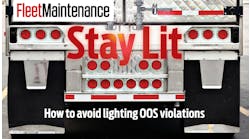You can avoid fifty percent of your maintenance headaches by spec'ing properly and then following the manufacturers recommended maintenance practices," says Mike Grace, director, fleet management with South Florida Water Management District (SFWMD) in West Palm Beach, Florida. SFWMD is a regional agency of the state of Florida whose responsibilities include managing and protecting water resources of the region, which covers 16 counties with five water management districts.
THE 3 T's
The 3 T's—Technicians, Tools, and Training—are all necessary components to a successful shop. So, how do utility fleet managers acquire the 3 T's to best serve their operations?
Grace offers that training is the wildcard. His 32 technicians are ASE certified and take advantage of training from companies such as DELCO for electrical systems. "Unless you have some huge budget for training," he says, "you have to seek what's available and be resourceful."
He is secretary of FLAGFA (Florida Association of Governmental Fleet Administrators), an organization that has as its mission to help both large and small fleets strive for excellence in fleet management.
"We meet twice a year in Daytona Beach," says Grace. "We seek out training with hydraulic, electric, and other instructors and we pay about 75 percent of the training. The technician's employer pays the remaining 25 percent. A small city or small counties often cannot afford the cost to send technicians to training, but if we sponsor a guy, we can bring the prices down for that employer."
He adds, "We'll purchase tools that we do a lot of repairs with. For example, in Palm Beach, we bought an on-the-vehicle brake lathe because almost everything we have is 4WD. We took a five-hour job down to less than two hours."
SRP depends on part suppliers, dealerships and manufacturers to provide training on vehicles purchased from an OEM, but they also use independent training associations.
"We have an established, state-approved four-year apprenticeship program and we add apprentices to the program when we forecast a technician to retire," says Ybarra. "We also hire technicians from outside the company. We look for technicians with aerial and construction equipment experience and train them in areas they lack experience in.
"TRUCKS AND BOATS
Grace oversees a mixed fleet of 1,000 units including sedans, SUVs, bulldozers, bucket trucks, derricks—as well as 44 airboats—that bring up some interesting maintenance issues. He says 13 of the airboats have aircraft engines and 31 have Chevrolet 350 engines. These craft see constant engine loading and vibration from the propeller, and therefore receive short oil changes and thorough inspections for fatigue cracks in the hull and rigging loose fittings and bolts.
The more common vehicles in his fleet are the 225 pickups and 145 SUVs that are mostly GMC K2500's and GM Blazer/Jimmy SUV's. All are 4X4 and most have winches.
"Public works personnel use our pickups," Grace says, "and the scientists and construction workers who are revitalizing the Florida Everglades, use SUVs."
He explains that with eight facilities, they get very little in the day-to-day maintenance. "Most shops' bread and butter is changing oil," says Grace. "Our day runs from 7 a.m. to 3:30 p.m., and half of our vehicles are not domiciled where the shop is. We have vendors come on site and change oil after hours rather than take the time of one of our people to bring vehicles in to have the oil changed or for some other easy service item."
Grace adds, "We're about 50 percent outsource. We don't do paint and body, transmissions, glass, or upholstery."
He is optimistic about new technology. "We've ordered some Ford Escape hybrids and they're under warranty. We have three Toyota Prius vehicles on the property and six more ordered. It's the right thing to do. We've got a long warranty with these units and we haven't bought many of the extended warranties. I have confidence in Detroit and Japan and I know they're going to make it work. It's only going to get better."
POWER IN ARIZONA
In the southwest, the Salt River Project Agricultural Improvement and Power District (SRP) is a water and power municipality in Phoenix, AZ. SRP is the nation's third-largest public power utility and one of Arizona's largest water suppliers, providing power to customers throughout a 2,900-square-mile service territory in central Arizona. The District provides electricity to nearly 860,000 retail customers in the Phoenix area.
SRP's Ray Ybarra, fleet maintenance supervisor, and transportation manager Jim Wood say that the SRP fleet has approximately 2,200 pieces of rolling stock that includes light, medium, heavy duty and construction equipment. But, it's the 190 medium-duty bucket and derrick trucks that support the power grid system have the highest priority.
"We have several hybrids in the fleet," says Ybarra. "We currently have six 2005 Ford Escape hybrids and one 2005 Chevrolet Silverado hybrid. We purchased them to evaluate hybrid technology for future fleet opportunities."
Ybarra and Wood explain that while their technicians are trained on these hybrids, they do not maintain the vehicles. Rather, they use the dealership for maintenance support under warranty.
A GREENER CANADA
Kyle Rees is fleet manager with Toronto Hydro-Electric in Toronto, Ontario, Canada. Toronto Hydro-Electric System Limited is the largest municipal electric distribution utility in Canada. The utility distributes approximately 18 percent of Ontario's electricity and serves approximately 673,000 customers.
Rees' fleet of 700 vehicles is a mix of cars, vans, pickups, and minivans. Small and light duty vehicles are from GM, Ford, Chrysler, Honda, Toyota, Infinity, Acura, Volvo, and Audi. Medium and heavy-duty trucks are Freightliner, Sterling, Ford, International, and Western Star. Rees offers that many of his vehicles run on bio-diesel and that Toronto Hydro was the first to bring the bio-diesel vehicles to Toronto.
Renzo Cacciotti, P. Eng., supervisor —Fleet Assets and Maintenance with Toronto Hydro Electric explains that there is an environmental initiative in Toronto and specifically within Toronto Hydro. "Anything that can be done to reduce emissions is positive in the eyes of our company," he says.
Toronto Hydro's bread and butter vehicles are their 103 single bucket trucks.
"The challenge in maintaining these vehicles is two-fold," says Cacciotti. "First, the vehicle is actually three components - a chassis, an aerial device, and a body. The chassis and aerial have specific maintenance requirements that we try to keep lined up so that when a complete unit comes in for its PM, it does not need to come back for four months, 300 PTO hours, 300 engine hours or 5,000 km, which are our maintenance parameters. We do little or no maintenance to the body other than greasing hinges."
He continues, "The second challenge is getting the vehicle off the road to complete the maintenance, specifically the aerial device. As they carry a lineperson 40 to 65 feet in the air, they must be inspected for due diligence. Aerial devices are insulated from high voltages and must be properly maintained to keep the unit in proper working order and keep the operator safe. Also, approximately 20 of these are emergency vehicles that run 24/7."
Toronto Hydro is currently completing the second year of a three-year General Motors pilot program for hybrids. Three Chevrolet Silverado 1500's went into service in June of 2004 and are used by supervisory staff in the field. Cacciotti offers that the pilot program vehicles will be returned to GM after the term and feedback will most likely include maintenance records.
Toronto Hydro has three more of these trucks as well as five, 2003 Honda Civic hybrids and one, 2001 Toyota Prius hybrid that are not part of the pilot program.
DAY-TO-DAY CHALLENGES
Aside from the obvious challenges of maintaining a large fleet of vehicles, these managers point to other factors that test them in the day-to-day.
"We have other corporate initiatives such as safety, training and budgets," says Cacciotti.
"We have an eclectic fleet spread over 16 counties and eight maintenance shops," says Grace. "One shop only has one guy and sometimes, he's out helping the operations side."
He adds, "If it's a piece of equipment, you have some showstoppers such as a Gradall, a bulldozer, etc. When it goes down, you've got four people out of work. Anything that is the primary piece of equipment such as an excavator or a crane gets top priority."
SRP's Ybarra and Wood offer this list, "Our aging workforce, technical training, price of fuel, and now, cost of tires for our fleet are our major challenges."
GROUND CONTROL
Control over expenses and maintenance items keep these managers and their operations thinking outside the toolbox to improve ROI. SFWMD's biggest expense is brakes and then tires, but fuel is the single largest expense for both Toronto Hydro and SRP.
SRP's principal engineer finance person Bob Fedock explains that SRP currently "hedges" its vehicle fuel needs for an entire budget year.
"The year's fuel budget is established using projected monthly quantities of fuel needed and applying the unit costs for that fuel based on the prices in the commodities market," says Fedock. "Once the budget is approved, SRP places orders in the commodities market for delivery of the estimated fuel needs for each month at the market price. Prior to the first of the month, SRP sells the fuel contract for that month in the commodities market. If the price at the time of the sale has gone up since the contract was purchased, SRP will make money on the hedge, but will also be paying higher costs for fuel. If the price has gone down, SRP will lose money on the hedge but will be paying lower costs for fuel. Hedging reduces the risk of large swings in the fuel budget."
How do you best achieve the return on investment for your fleet?
"It comes down to how good your specifications are," says Grace. "We discuss the options as far as repair vs. replace. The property management group that disposes of our used equipment now uses eBay with great success."
Ybarra and Wood explain that they involve the users in the acquisition process to ensure the right equipment/vehicles are purchased for the work applications. Also, they ensure resources are available to maintain an effective preventative maintenance program. "Due to our PM program, we get a good price at auction when we retire our equipment," says Ybarra.
Ybarra adds, "It took approximately one year to develop a written PM standard for our technicians to use and follow. There were several issues we had to deal with such as PM intervals needed to be correct and adjusted based on oil samples, to train our technicians on proper PM inspections, and to continue to review and update the PM program as engines, transmission and hydraulic oils changed. By performing and following this process, our equipment breakdowns are minimal and equipment availability is almost 100 percent for our internal customers at the start of the work day."
Five Steps toward Optimizing a Vocational Fleet Preventive Maintenance Program
A solid preventive maintenance program can help vocational fleet managers keep vehicle repair costs and downtime to a minimum. But an inefficient, poorly designed program can cost time and money. Robert Johnson, fleet management liaison for the National Truck Equipment Association (NTEA), says vocational fleet managers should review several areas to evaluate whether their preventive maintenance programs are optimized.
1. Analyze your fleet maintenance records. Are you tracking enough of the right information to make informed maintenance decisions? For example, simply recording that "front end work" was completed on a vehicle does not give you enough information to detect failure trends for individual front end components. Your records should indicate at least the make and model of vehicle, date and mileage at time of service, and services performed to specific components. But remember, "All the records in the world won't do a thing for you if you don't analyze the data," Johnson says.
2. Examine any unexplained incidents of demand maintenance that were required between scheduled preventive maintenance intervals. Look for trends. If a number of particular failures occur on certain vehicles, determine if it is possible to adjust your preventive maintenance program to eliminate those failures in the future. Some vehicles will be more prone to problems with certain systems than others. You may need to develop a different preventive maintenance schedule for certain makes and models of vehicles in the fleet or for those operating in specific applications. Remember, one generic preventive maintenance program may not work equally well for all fleets, or even for all vehicles within a particular fleet.
3. A good measure of the efficiency of your preventive maintenance program is the number of "touches" technicians have on a vehicle. For example, you may have a vehicle scheduled for preventive maintenance three times a year, but find that it was actually pulled in for service six times - the three scheduled services, plus another three times for various other services such as government-required safety and emissions inspections. Proper scheduling would have enabled these inspections to have been handled at the same time as the preventive maintenance. Every time a technician touches a vehicle, it costs you money and represents possible downtime. On average, every vehicle "touch" takes a minimum of an hour of labor. Proper planning can minimize these costs.
4. Determine whether you could be doing a better job of predictive maintenance. Use your records to calculate your fleet's average service life for various components, so you know when to proactively replace them. For example, say you find that Brand X alternators on Brand Y vehicles fail at around 85,000 miles on average. Your preventive maintenance schedule calls for 8,000-mile service intervals. Your service schedule, then, should include an alternator replacement as part of the first preventive maintenance service after 77,000 miles.
5. It is possible to set preventive maintenance intervals too close together. Intervals should be based on the type of vehicle application, usage (mileage, hours, operating environment, etc.), OEM warranty requirements and regulatory requirements. "Far too many companies have one preventive maintenance schedule. But what's right for one vehicle may be too much for another vehicle and not enough for a third," Johnson says. "There is no one magic number for every vehicle in your fleet. And just because you've always done it, doesn't mean you have to continue doing it." Start your review by going back to the manufacturer's recommendations for the type of service for which you are using the vehicle. If your preventive maintenance intervals for the vehicle are more frequent than the manufacturer recommends, try conducting a lubricant analysis, primarily of engine oil. Also check to see how much residual lubricant is present in unsealed joints at each service visit. If the oil analysis shows the oil is still good, there is still plenty of lubricant in each joint, and you have a good failure history, you may want to consider extending the service interval by a month and checking the same factors again. "It's a combination of science with trial and error," Johnson explains.
Johnson will discuss these techniques and others in greater detail in an educational session at The Work Truck Show® 2006.
He will be joined by Dave Williams, fleet regional manager, Verizon Communications (Valhalla, NY), and Larry Allen, highway equipment manager, Pennsylvania Department of Transportation Equipment Division (Harrisburg, PA), in a session titled "Fleet Preventative Maintenance Programs - Is My Work Truck Program Working?" The Work Truck Show 2006 will be held in conjunction with the 42nd Annual NTEA Convention at the Georgia World Congress Center in Atlanta, GA. Educational sessions start Feb. 28, with the show floor opening on March 1. To learn more, visit NTEA.com or call 1-800-441-NTEA (6832).


